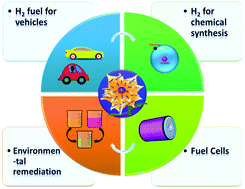Recent advances in metal sulfides: from controlled fabrication to electrocatalytic, photocatalytic and photoelectrochemical water splitting and beyond
Abstract
In recent years, nanocrystals of metal sulfide materials have attracted scientific research interest for renewable energy applications due to the abundant choice of materials with easily tunable electronic, optical, physical and chemical properties. Metal sulfides are semiconducting compounds where sulfur is an anion associated with a metal cation; and the metal ions may be in mono-, bi- or multi-form. The diverse range of available metal sulfide materials offers a unique platform to construct a large number of potential materials that demonstrate exotic chemical, physical and electronic phenomena and novel functional properties and applications. To fully exploit the potential of these fascinating materials, scalable methods for the preparation of low-cost metal sulfides, heterostructures, and hybrids of high quality must be developed. This comprehensive review indicates approaches for the controlled fabrication of metal sulfides and subsequently delivers an overview of recent progress in tuning the chemical, physical, optical and nano- and micro-structural properties of metal sulfide nanocrystals using a range of material fabrication methods. For hydrogen energy production, three major approaches are discussed in detail: electrocatalytic hydrogen generation, powder photocatalytic hydrogen generation and photoelectrochemical water splitting. A variety of strategies such as structural tuning, composition control, doping, hybrid structures, heterostructures, defect control, temperature effects and porosity effects on metal sulfide nanocrystals are discussed and how they are exploited to enhance performance and develop future energy materials. From this literature survey, energy conversion currently relies on a limited range of metal sulfides and their composites, and several metal sulfides are immature in terms of their dissolution, photocorrosion and long-term durability in electrolytes during water splitting. Future research directions for innovative metal sulfides should be closely allied to energy and environmental issues, along with their advanced characterization, and developing new classes of metal sulfide materials with well-defined fabrication methods.



 Please wait while we load your content...
Please wait while we load your content...